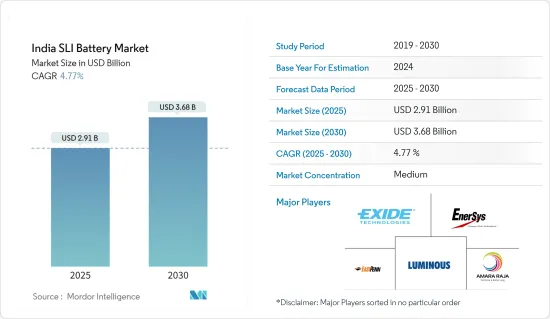Need help finding what you are looking for?
Contact Us
PUBLISHER: Mordor Intelligence | PRODUCT CODE: 1636251

PUBLISHER: Mordor Intelligence | PRODUCT CODE: 1636251
India SLI Battery - Market Share Analysis, Industry Trends & Statistics, Growth Forecasts (2025 - 2030)
PUBLISHED:
PAGES: 100 Pages
DELIVERY TIME: 2-3 business days
SELECT AN OPTION
The India SLI Battery Market size is estimated at USD 2.91 billion in 2025, and is expected to reach USD 3.68 billion by 2030, at a CAGR of 4.77% during the forecast period (2025-2030).

Key Highlights
- Over the medium term, growing demand for SLI batteries from industrial and agricultural applications and increasing adoption of motor vehicles are expected to drive the demand for SLI batteries during the forecast period.
- On the other hand, the increasing penetration of alternative battery chemistries restrains the growth of the Indian SLI battery market.
- Nevertheless, increased focus on battery recycling and expansion in emerging markets for both new vehicles and after-market replacements are expected to create significant opportunities for SLI battery market players in the near future.
India SLI Battery Market Trends
The Increasing Adoption of Motor Vehicles Drives the Market
- The increasing adoption of motor vehicles in India drives the growth of the market. The increasing adoption of motor vehicles is leading to increased demand for reliable and efficient automotive batteries.
- Robust automotive production and sales bolster the demand for SLI batteries in Asia. China and India are significant automotive markets, and SLI batteries are used in new vehicles and after-market replacements. The sales of electric vehicles rose significantly over the study period.
- According to the International Energy Agency, in 2023, the total number of EVs sold in India was 82,000, an increase of 70.8% compared to 2022. Sales are expected to rise exponentially in the coming years as numerous projects are initiated, which will raise the demand for SLI batteries during the forecast period.
- In order to achieve sustainable transportation, the country is actively promoting the use of electric vehicles (EVs). The country is embracing the electric revolution as the world transitions toward a greener future by encouraging the use of these vehicles.
The Automotive End-user Segment is Expected to Grow
India SLI Battery Industry Overview
Additional Benefits:
Product Code: 50003530
TABLE OF CONTENTS
1 INTRODUCTION
- 1.1 Scope of the Study
- 1.2 Market Definition
- 1.3 Study Assumptions
2 EXECUTIVE SUMMARY
3 RESEARCH METHODOLOGY
4 MARKET OVERVIEW
- 4.1 Introduction
- 4.2 Market Size and Demand Forecast in USD billion, till 2029
- 4.3 Recent Trends and Developments
- 4.4 Government Policies and Regulations
5 MARKET SEGMENTATION
6 COMPETITIVE LANDSCAPE
7 MARKET OPPORTUNITIES AND FUTURE TRENDS
Have a question?


SELECT AN OPTION
Have a question?


Questions? Please give us a call or visit the contact form.
